APPENDIX B
A Schematic of Chinese History and Chinese Dynasties
(NB: dates are approx. and subj. to criticism in var. sources)
Naming conventions of Chinese Emperors: There are many different ways that Chinese Emperors are named and known in history. The conventions, however, allow for a number of different patterns by which different emperors are known in history texts.
First, all emperors, of course, have birth names. They are, however, rarely identified exclusively by their birth names, and usually only the founding emperor of a dynasty will be known historically by that name, and even then, only until they become emperors.
In addition emperors may be identified by several other possible names:
- a temple name
- a posthumous temple name
- a reign or era name (often multiple era names in one reign)
- a posthumous era name
- a courtesy name
Different dynasties will often have different naming styles, particularly the non-Chinese dynasties.
In the lists below, the most usual references are to temple names or posthumous temple names, unless otherwise noted.
Note: dates are noted in the form bce=before common era [=BC]; ce=common era [=AD]
Neolithic: Stone Age Period
Three Sovereigns of the legendary period (sān huáng 三皇)
1. Suì rén shì (燧人氏) (said to have reigned for a half million years in the Pleistocene epoch ending 11,700 years ago: legendary discoverer of fire)
2. Fú xī (伏羲) 2852 to 2738 bce (legendary teacher of fishing, trapping and writing to the Ancients)
3. Shén nóng (神農/神农) The Farmer Emperor 2737 bce st. called the ‘Yan Emperor’ (Fiery or Flame Emperor) (yán dì 炎帝) (legendary teacher of farming to the Ancients)
Chinese legends say that there were a series of ‘Flame Emperors’ over a period of 500 years, ending in a battle lost to The Yellow Emperor: Huángdì (黃帝/黄帝).
Chalcolithic: Pre-Bronze Age Period
Huáng dì (黃帝/黄帝) The Yellow Emperor (founder of the Five Emperors dynasty) {~3709 to 2221 bce}
In legend, had a scribe named Cāng jié (倉頡/仓颉), who invented Chinese characters
Wǔ dì (五帝) The Five Emperors Period {~2697 to 2597 bce}
- Shǎo hào (少昊) {~2597 bce}
- Zhuān xū (顓頊/颛顼) {~2513 to 2435 bce} (grandson of Huángdì)
- Dì kù (帝嚳/帝喾) (great-grandson of Huángdì) also called Gāo xīn shì (高辛氏)
- Dì yáo (帝堯/帝尧) – also called Táng Yáo (唐堯/唐尧) according to tradition passed his rule to his most capable and virtuous Minister rather than passing it to his eldest son {~2397 to 2275 bce}
- Dì shùn (帝舜) {~2274 to 2222 bce}
-established the Abdication System to choose rulers according to ability, following the precedent of his predecessor Dì yáo.
Bronze Age Period
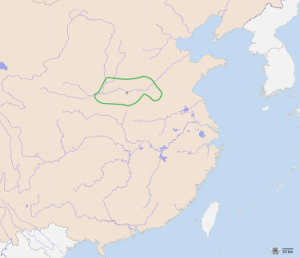 Approximate location of the Xià Dynasty ca. 1600 bce (Map courtesy of Wikipedia)
Approximate location of the Xià Dynasty ca. 1600 bce (Map courtesy of Wikipedia)
Xià Dynasty (xià cháo 夏朝) {~2205 to 1766 bce} – before written records – 17 kings
– Thought to have been located on the Yellow River from the confluence with the Wèi River in Héběi to approximately the area of Ānyáng in Hénán province, centered near the ancient city of Èrlǐtou (二里頭/二里头) (near what is now Yǎnshī (偃師/偃师), Hénán.)
This ‘dynasty’ exists as much in myth as in validated history. There were no written records of this period and it is known mostly from pottery shards, as later written records are thought to record myths of virtuous rulers rather than actual historical fact.
| Ruler Name | Rel. to prior ruler | Dates of Rule | Length of Reign |
| 1. XiàYú (Yú shùn 虞舜) aka Yú the Great (Dà yú 大虞) | r. ~2205 to 2160 bce st. said to be 2255 to 2208 bce –born, Sì Wénmìng (姒文命) | ruled 45 years | |
| -traditionally credited with having built a flood-control system for the Yellow River during the (immediately preceding) Dì shùn (帝舜) Emperor period which succeeded in stopping the annual flooding and allowed for the increase in agricultural production leading to prosperity, whereupon he was made emperor by a grateful people -wanted to pass the kingdom to Gāo yáo (皋陶/臯陶), his Minister of Justice, but Gāo yáo died, and rule passed to his son Qǐ, instead. |
|||
| 16 additional kings from 2146 to 1675 bce | Click to Display | ||
Shāng Dynasty (shāng yīn cháo 商殷朝) 1766 to 1123 bce (or, perhaps 1556 to 1046 bce instead, according to the Bamboo Annals) – 30 kings
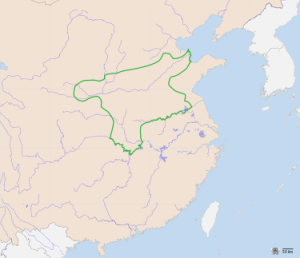 Shāng Dynasty ca. 1046 bce (Map courtesy of Wikipedia)
Shāng Dynasty ca. 1046 bce (Map courtesy of Wikipedia)
– ruled the Yellow River Valley in the area of southern Shānxī (山西), southern Héběi (河北), northern Hénán (河南) and western Shāndōng (山東/山东) provinces
– historically known for ‘tortoise-shell’ inscriptions, first archeological evidence of written characters consisting of divinations written on tortoise breast-plates and sheep scapula
| Ruler Name | Chinese Characters | Dates of Rule | Length of Reign |
| 1. Chéng Tāng | 成湯/成汤 (ruled as Tiān Yǐ 天乙) | r. 1675 to 1646 bce | ruled 29 years |
| 29 additional kings from 1646 to 1046 bce | Click to Display | ||
Iron Age Period
Zhōu Dynasty (zhōu cháo 周朝) 1174 to 221 bce
Western Zhōu dynasty (xī zhōu cháo 西周朝) 1174 to 771 bce, st. noted as 1046 to 771 bce (aka Earlier Zhōu dynasty) (qián zhōu cháo 前周朝) – 13 kings
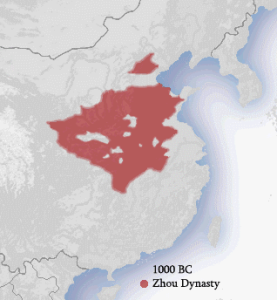 Zhou Dynasty ca. 1000 bce (Map courtesy of Wikipedia)
Zhou Dynasty ca. 1000 bce (Map courtesy of Wikipedia)
The Zhōu Dynasty, while given the courtesy appellation of ‘dynasty’ was not a dynasty in the same sense as the Qín or any of the later dynasties.
It began as a small Kingdom, and evolved/devolved into a series of related family ‘commanderies’ that gradually, over time, became more and more independent of each other, essentially ending up as small Kingdoms which were allies in times of war, and peaceful competitors at other times.
| Ruler Name | Pinyin | Chinese Characters | Dates of Rule | Length of Reign |
| 1. King Wǔ of Zhōu | Zhōuwǔ Wáng | 周武王 | r. 1046 to 1043 bce | ruled 3 years |
| 12 additional kings from 1042 to 771 bce | Click to Display | |||
Eastern Zhōu dynasty (dōng zhōu cháo 東周朝/东周朝) 770 to 221 bce, (aka Later Zhōu dynasty) (hòu zhōu cháo 後周朝/后周朝) including:
- The Spring and Autumn Period (chūn qiū shí dài 春秋時代/春秋时代) 770 to 476 bce
- The Warring States Period (zhàn guǒ shí dài 戰國時代/战国时代) 475 to 221 bce
Eastern Zhōu: The Spring and Autumn Period – 14 kings
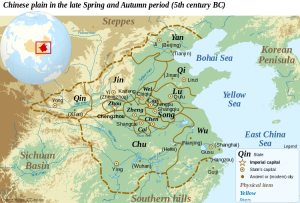 The Spring and Autumn Period, ca. 5th cent. bce (Map courtesy of Wikipedia)
The Spring and Autumn Period, ca. 5th cent. bce (Map courtesy of Wikipedia)
| Ruler Name | Pinyin | Chinese Characters | Dates of Rule | Length of Reign |
| 1. King Píng of Zhōu | Zhōupíng Wáng | 周平王 | r. 770 to 720 bce | ruled 50 years |
| 13 additional kings from 719 to 476 bce | Click to Display | |||
Era of the Five Hegemons during the Spring and Autumn Period – (chūn qiū wǔ bà 春秋五霸) 770 to 476 bce
-This era was contemporaneous with the Eastern Zhōu period. The function of the Hegemons (in the cases of the ducal hegemons) was the protection of their feudal overlords, the kings of the Eastern Zhōu.
-Dates, names and exact locations are subjects of controversy
-Three of the Hegemons are generally agreed:
- Duke Huán of Qí (Qíhuán Gōng 齊桓公/齐桓公)
- Duke Wén of Jìn (Jìnwén Gōng 晉文公/晋文公)
- King Zhuāng of Chǔ (Chǔzhuāng Wáng 楚莊王/楚庄王)
-There is disagreement as to the identities of the other two:
- Duke Móu of Qín (Qínmóu Gōng 秦繆公/秦缪公)
- Duke Xiāng of Sòng (Sòngxiāng Gōng 宋襄公)
- King Hélù of Wú (Wúhélù Wáng 吳河路王/吴河路王)
- King Gōujiàn of Yuè (Yuèwáng Gōujiàn 越王勾踐/越王勾践)
Eastern Zhōu: The Warring States Period
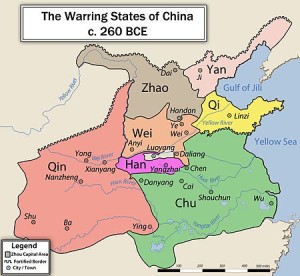 The Warring States ca. 260 bce (Map courtesy of Wikipedia)
The Warring States ca. 260 bce (Map courtesy of Wikipedia)
The disintegration of the Zhōu dynasty during the Spring and Autumn Period left a disorganized system of mini-states, each styling itself as a ‘Kingdom’. Eventually, these mini-states resolved themselves into seven states, in total.
Of the seven States of this Era, six were conquered by the Qín (秦) over a period of 25 years by the ruler, Qín shǐ huáng dì (秦始皇帝) from the beginning of his reign as King Zhèng of Qín (秦政王, the founding emperor of the Qin dynasty, Qínzhèng Wáng) in 246 bce to his unification of China by completing the conquest of the other six competing states by 221 bce:
- Hán (韓/韩) conquered in 230 bce
- Wèi (魏) conquered in 225 bce
- Chǔ (楚) conquered in 223 bce
- Yān (燕) conquered in 222 bce
- Zhào (趙/赵) conquered in 222 bce
- Qí (齊/齐) conquered in 221 bce
Dynastic Period of Unified China 221 bce to 1912 ce (with a 370 year interregnum from the fall of the Later Hàn Dynasty (220 ce) to the Suí Dynasty (590 ce))
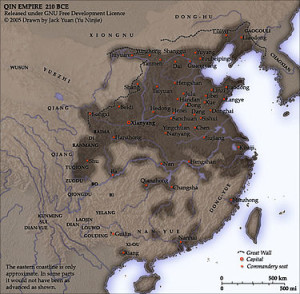 The Qín Dynasty (Map courtesy of Wikipedia)
The Qín Dynasty (Map courtesy of Wikipedia)
Qín Dynasty (qín cháo 秦朝) 221 to 207 bce
Ruled by King Zhèng of Qín (秦政王) the founding emperor of the Qín dynasty (who ruled as Qín shǐ huáng dì) (秦始皇帝) until his death in 210 bce, not to be confused with Huáng dì (黃帝/黄帝), The Yellow Emperor of the Chalcolithic Period (above). Note that, while he ruled the state of Qín as King for 25 years, he only ruled as Emperor of the dynasty for an additional 11 years. His 36 years of rule, however, were arguably the most consequential 36 years in China’s history.
-reputed to have burned books he considered subversive, and to have buried 460 Confucian scholars alive sometime between 213 and 210 bce (fénshū kēngrú 焚書坑儒/焚书坑儒) NB.: It should be noted that some modern scholars believe the burying of scholars alive to be myth.
-His son Hú hài (胡亥) was placed on the throne by his advisors, and ruled for 3 years as Qín Èrshì (秦二世) (r. 210 to 207 bce). He was murdered by his chief advisor, the eunuch Zhào Gāo (趙高/赵高), who was in turn killed by the third Qín emperor, Zǐyīng (子嬰/子婴) in 207 bce.
Zǐyīng ruled for only 3 months until he was overthrown when rebels captured Xiányáng, (咸陽/咸阳) his capital city in Shaanxi (shǎn xī 陝西/陕西) Province to create the Hàn dynasty.
The Hàn, Western Hàn or Earlier Hàn Dynasty (hàn cháo 漢朝/汉朝) 206 bce to 7 ce – 15 emperors (identified here by posthumous names)
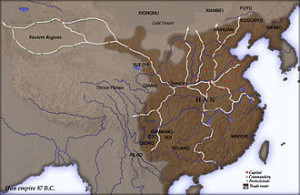 Hàn Dynasty ca. 87 bce (Map courtesy of Wikipedia)
Hàn Dynasty ca. 87 bce (Map courtesy of Wikipedia)
– Lasted over 400 years.
– The second imperial dynasty.
– Famous in Chinese history: Chinese people today consider themselves ‘Hàn’ people. Chinese characters, codified during this dynasty are still called ‘Hàn’ characters.
– Development of a money economy, general rise in prosperity over the period of the dynasty.
– Rise in Confucianism.
– Subjugation of the Xiōngnú peoples of the Mongolian plains beyond the Great Wall consolidating the fractured residue of the Qín dynasty, and extending the dominion of China into Central Asia.
– Opening up of the Silk Road for trade into the Middle East at the same time as the development of the ‘Tea-Horse Road’ trade (that is, the original reason for extending the empire towards Central Asia: the desire on the part of Emperor Wǔ of Hàn (漢武帝/汉武帝 Hànwǔ Dì) to secure the larger Ferghana Valley horses for use in large numbers by Chinese cavalry which was necessary to subjugate the Xiōngnú, who were horse-borne plains people.) The Ferghana Valley horses were taller and heavier than the extant variety indigenous to China at that time. It is famously the horse known in the West for its use in the widely copied Táng dynasty horse statues. (See statue picture here)
– Advances in science and technology such as the invention of paper and advances in mathematics.
| Ruler Name | Pinyin | Chinese Characters | Dates of Rule | Length of Reign |
| 1. Emperor Gāozǔ founding emperor | birthname: Liú Bāng 劉邦/刘邦 | 高祖 | r. 202 to 195 bce | ruled 7 years |
| 14 additional emperors (and 1 Xīn Dynasty usurper) from 195 bce to 25 ce | Click to Display | |||
The Eastern or Later Hàn Dynasty (hòu hàn cháo 後漢朝/后汉朝) 25 to 220 ce – 14 emperors
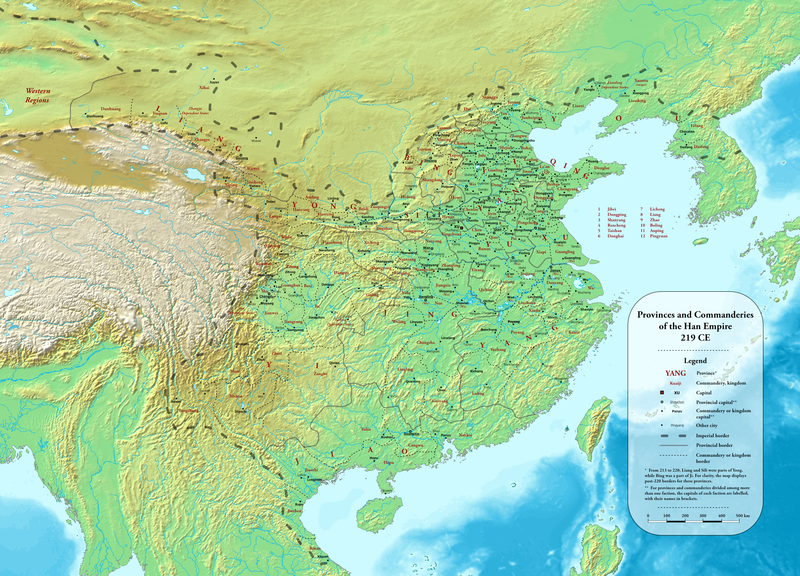 Eastern Han Dynasty (Map courtesy of Wikipedia)
Eastern Han Dynasty (Map courtesy of Wikipedia)
The Hàn (or Western Hàn) Dynasty and the Eastern (or Later Hàn) Dynasty were separated by the Xīn Dynasty (xīn cháo 新朝, 9 to 23 ce) ruled by the usurper Wáng Mǎng. Social upheaval caused primarily by the silting up of the Yellow River, resulted in the overflowing of its banks creating massive social dislocations in Shāndōng, and lead to civil insurrections during which the usurper was killed. Subsequently, the Hàn Dynasty was restored with its capital moved from Cháng’ān (today known as Xī’ān, in Shǎnxī/Shaanxi 陜西/陕西 province) to Luòyáng (in western Hénán province).
| Ruler Name | Pinyin | Chinese Characters | Dates of Rule | Length of Reign |
| 1. Emperor Guāngwǔ | Guāngwǔ Dì | 光武帝 | r. 25 to 57 ce | ruled 32 years |
| 13 additional emperors from 57 to 220 ce | Click to Display | |||
The Six Dynasties Period (liù cháo shí dài 六朝時代/六朝时代) (220-589ce) and The Age of Three Kingdoms (sān guó shí dài 三國時代/三国时代) sometimes called the Wèi Jìn Southern and Northern Dynasties (wèi jìn nán běi cháo 魏晋南北朝)
This next period of Chinese dynastic history can be a bit confusing, as dates tend to overlap. This is because the Hàn dynasty fragmented into a number of different kingdoms, each governing different areas whose rise and fall differed according to local conditions.
These different kingdoms, especially in the northern and western border areas, were often peopled with newly-Sinified non-Hàn peoples who took Chinese dynastic reign names. This period begins an interregnum of 370 years during which China was fractionated into competing Kingdoms and Dynasties. It will not be until the Suí Dynasty (590 to 618 ce) that China is again united into one dynasty (and nation.)
Most people can name a few of the non-Chinese dynasties, and a few of the enemies of China on its northern borders (Xiōngnú, Mongols, etc.) But the reality is that there were many groups on China’s northern borders that presented problems over the years, particularly after the fall of the Hàn dynasty. Many of these groups (Tuòbá tribes [拓拔], Tibetan groups, Turkic-speaking Central Asian tribes, Göktürks {Tūjué [突厥]}, etc.) formed the short-lived dynasties during the Six-Dynasties Period and the Sixteen Kingdoms Period that followed it. These groups held sway for short periods, were overcome by others and their remnants were then absorbed by one or more of the competing groups and disappeared to history.
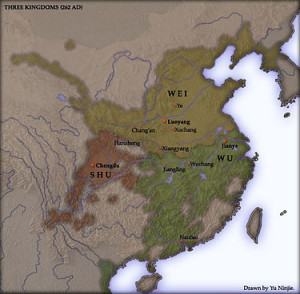 The Three Kingdoms, after the fall of the Hàn (Map courtesy of Wikipedia)
The Three Kingdoms, after the fall of the Hàn (Map courtesy of Wikipedia)
The Three Kingdoms (sān guó 三國/三国) 220 to 280 ce
- Shǔ Dynasty (shǔ cháo 蜀朝) 221 to 264 ce
- Wèi Dynasty (wèi cháo 魏朝) 220 to 265 ce
- Wú Dynasty (wú cháo 吳朝/吴朝) 222 to 280 ce
Following the fall of the Later Hàn Dynasty, China disintegrated into many small kingdoms and entered a period of constant war that resulted in changes to the borders of the various ‘dynasties’ on a constant basis until reunited by the Jin Dynasty which essentially reconstituted the Chinese empire in 265 ce.
The Six Dynasties (liù cháo 六朝) 220 or 222 to 589 ce
The Northern Dynasties (běi cháo 北朝) 386-577ce, composed first of Northern Wei (386-535ce), and then fractured into the Western Wei (535-557ce), Eastern Wei (534-550ce), Northern Zhou (557-581ce) and Northern Qi (550-577ce).
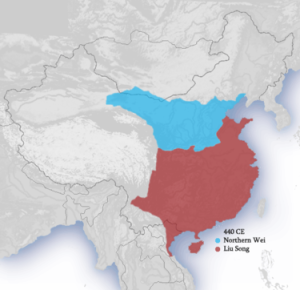 Southern and Northern Dynasties, 440 ce -N. Wei and LiuSong (Map Courtesy of Wikipedia)
Southern and Northern Dynasties, 440 ce -N. Wei and LiuSong (Map Courtesy of Wikipedia)
Northern and Southern Dynasties (nán běi cháo 南北朝) 317 to 589 ce
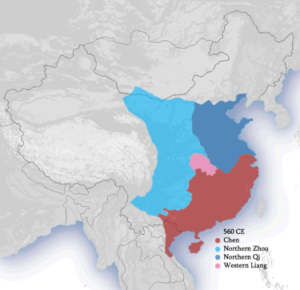 Northern and Southern Dynasties ca.560 ce (Map courtesy of Wikipedia)
Northern and Southern Dynasties ca.560 ce (Map courtesy of Wikipedia)
- Western Jìn Dynasty (xī jìn cháo 西晉朝/西晋朝) 265 to 317 ce – 5 emperors
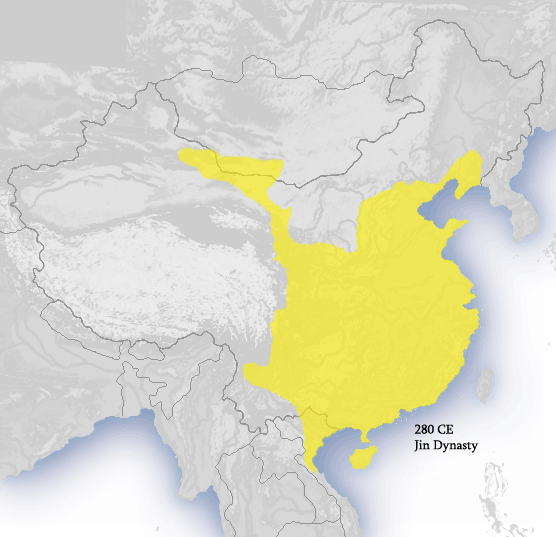 Western Jin Dynasty ca. 280ce (Map courtesty of Ian Kiu and Wikipedia)
Western Jin Dynasty ca. 280ce (Map courtesty of Ian Kiu and Wikipedia)
| Ruler Name | Chinese Characters | Birthname | Dates of Rule | Length of Reign |
| 1. Emperor Wǔ of Jìn (Jìnwǔ Dì) |
晉武帝/晋武帝 | Sīmǎ Yán 司馬炎/司马炎 |
r. 266 to 290 ce | ruled 24 years |
| 4 additional emperors from 290 to 316 ce | Click to Display | |||
The Southern Dynasties (nán cháo 南朝) 317 to 589 ce, composed of the Liu Song 420-479ce, Southern Qi 479-502ce, Liang 502-557ce, Chen 557-589ce, and Western Liang 555-587ce
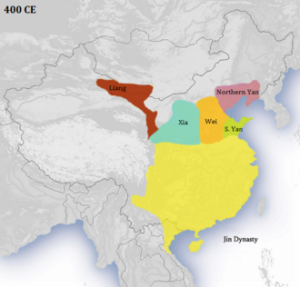 Eastern Jin Dynasty ca.400 ce (Map courtesy of Wikipedia)
Eastern Jin Dynasty ca.400 ce (Map courtesy of Wikipedia)
- The Six Dynasties Period and Eastern Jìn Dynasty (dōng jìn cháo 東晉朝/东晋朝) 317 to 420 ce – 11 emperors
| Posthumous Name | Chinese Characters | Birthname | Dates of Rule | Length of Reign |
| 1. Emperor Yuán of Jìn (Jìnyuán Dì) |
晉元帝/晋元帝 | Sīmǎ ruì 司馬睿/司马睿 |
r. 318 to 323 ce | ruled 5 years |
| 10 additional emperors from 323 to 420 ce | Click to Display | |||
- Liúsòng Dynasty (liú sòng cháo 劉宋朝/刘宋朝) aka Former Song (qián sòng 前宋) 420 to 479 ce – 9 emperors
| Ruler Name | Chinese Characters | Pinyin | Dates of Rule | Length of Reign |
| 1. Emperor Wǔ of Liúsòng | 劉宋武帝/刘宋武帝 | Liúsòngwǔ Dì | r. 420 to 422 ce | ruled 2 years |
| 8 additional emperors from 423 to 479 ce | Click to Display | |||
- Southern Qí Dynasty (nán qí cháo 南齊朝/南齐朝) 479 to 502 ce – 7 emperors
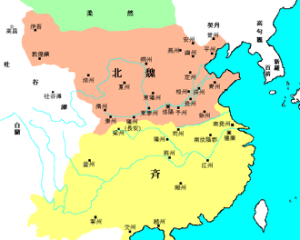 S. Qi and N. Wei Dynasties 550 to 557 ce
S. Qi and N. Wei Dynasties 550 to 557 ce
| Ruler Name | Chinese Characters | Pinyin | Dates of Rule | Length of Reign |
| 1. Emperor Gāo of Qí | 齊高帝/齐高帝 | Qígāo Dì | r. 479 to 482 ce | ruled 3 years |
| 6 additional emperors from 482 to 502 ce | Click to Display | |||
- Liáng Dynasty (liáng cháo 梁朝) (aka Southern Liáng Dynasty) (nán liáng cháo 南梁朝) 502 to 557 ce – 6 emperors
| Ruler Name | Chinese Characters | Pinyin | Dates of Rule | Length of Reign |
| 1. Emperor Wǔ of Liáng | 梁武帝 | Liángwǔ Dì | r. 502 to 549 ce | ruled 47 years |
| 5 additional emperors from 549 to 557 ce | Click to Display | |||
- Chén Dynasty (chén cháo 陳朝/陈朝) (aka Southern Chén Dynasty) (nán chén cháo 南陳朝/南陈朝) 557 to 589 ce – 5 emperors
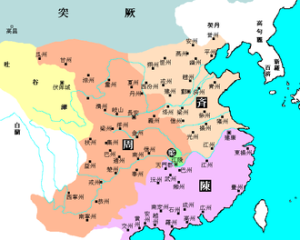 Chen Dynasty ca. 557 ce (purple) (Map Courtesy of Wikipedia)
Chen Dynasty ca. 557 ce (purple) (Map Courtesy of Wikipedia)
| Ruler Name | Chinese Characters | Pinyin | Dates of Rule | Length of Reign |
| 1. Emperor Wǔ of Chén | 陳武帝/陈武帝 | Chénwǔ Dì | r. 557 to 559 ce | ruled 2 years |
| 4 additional emperors from 559 to 589 ce | Click to Display | |||
- Sixteen Kingdoms Period (shí liù guó 十六國/十六国) 304 to 439 ce
| Kingdom Name | Pinyin | Chinese Characters | Dates of Rule | Duration of Dynasty |
| 1. Former Liáng | qián liáng | 前涼/前凉 | 320 to 376 ce | 56 years |
| 2. Later Liáng | hòu liáng | 後涼/后凉 | 386 to 403 ce | 17 years |
| 3. Northern Liáng | bĕi liáng | 北涼/北凉 | 397 to 439 ce | 42 years |
| 4. Southern Liáng | nán liáng | 南涼/南凉 | 397 to 414 ce | 17 years |
| 5. Western Liáng | xī liáng | 西涼/西凉 | 400 to 421 ce | 21 years |
| 6. Former Yàn | qián yàn | 前燕 | 337 to 370 ce | 33 years |
| 7. Later Yàn | hòu yàn | 後燕/后燕 | 384 to 407 or 409 ce | 23 or 25 years |
| 8. Northern Yàn | bĕi yàn | 北燕 | 407 or 409 to 436 ce | 27 or 29 years |
| 9. Southern Yàn | nán yàn | 南燕 | 398 to 410 ce | 12 years |
| 10. Former Qín | qián qín | 前秦 | 351 to 394 ce | 43 years |
| 11. Later Qín | hòu qín | 後秦/后秦 | 384 to 417 ce | 33 years |
| 12. Western Qín | xī qín | 西秦 | 385 to 400 ce and 409 to 431 ce | 15 years and 22 years |
| 13. Former Zhào (qián zhào 前趙/前赵) or Hàn Zhào (hàn zhào 漢趙/汉赵) or Northern Hàn (bĕi hàn 北漢/北汉) |
304 to 329 ce | 25 years | ||
| 14. Later Zhào | hòu zhào | 後趙/后赵 | 319 to 351 ce | 32 years |
| 15. Chéng Hàn | chéng hàn | 成漢/成汉 | 303 or 304 to 347 ce | 43 or 44 years |
| 16. Xià | xià | 夏 | 407 to 431 ce | 24 years |
Northern Dynasties (běi cháo 北朝) 386 to 581 ce
- Northern Wèi Dynasty 386 to 535 ce
- Eastern Wèi Dynasty 534 to 550 ce
- Western Wèi Dynasty 535 to 556 ce
- Northern Qí Dynasty 550 to 577 ce
- Northern Zhōu Dynasty 557 to 581 ce
- Northern Wèi Dynasty (běi wèi cháo 北魏朝) 386 to 535 ce – 16 emperors
| Ruler Name | Chinese Characters | Dates of Rule | Length of Reign |
| 1. Dàowǔ Dì | 道武帝 | r. 386 to 409 ce | ruled 23 years |
| 15 additional emperors from 409 to 535 ce | Click to Display | ||
- Eastern Wèi Dynasty (dōng wèi cháo 東魏朝/东魏朝) 534 to 550 ce – 1 emperor
| Ruler Name | Chinese Characters | Dates of Rule | Length of Reign |
| 1. Xiàojìng Dì | 孝靜帝/孝静帝 | r. 534 to 550 ce | ruled 16 years |
- Western Wèi Dynasty (xī wèi cháo 西魏朝) 535 to 556 ce – 3 emperors
| Ruler Name | Chinese Characters | Dates of Rule | Length of Reign |
| 1. Emperor Wén of Wèi (Wèiwén Dì) |
魏文帝 | r. 535 to 551 ce | ruled 16 years |
| 2. Emperor Fèi of Wèi (Wèifèi Dì) |
魏廢帝/魏废帝 | r. 552 to 554 ce | ruled 2 years |
| 3. Emperor Gōng of Wèi (Wèigōng Dì) |
魏恭帝 | r. 554 to 556 ce | ruled 2 years |
- Northern Qí Dynasty (běi qí cháo 北齊朝/北齐朝) 550 to 577 ce – 7 emperors
| Ruler Name | Chinese Characters | Dates of Rule | Length of Reign |
| 1. Wénxuān Dì | 文宣帝 | r. 550 to 559 ce | ruled 9 years |
| 6 additional emperors from 559 to 579 ce | Click to Display | ||
- Northern Zhōu Dynasty (běi zhōu cháo 北周朝) 557 to 581 ce – 5 emperors
| Ruler Name | Chinese Characters | Dates of Rule | Length of Reign |
| 1. Xiàomǐn Dì | 孝閔帝/孝闵帝 | r. 557 ce | ruled less than 1 year |
| 4 additional emperors from 557 to 581 ce | Click to Display | ||
Suí Dynasty (suí cháo 隋朝) 590 to 618 ce – 5 emperors
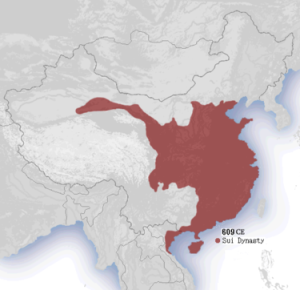 Suí Dynasty 609 ce (Map courtesy of Wikipedia)
Suí Dynasty 609 ce (Map courtesy of Wikipedia)
After an interregnum of 370 years (since the fall of the Eastern Hàn,) China is once again unified into a single dynasty uniting the Northern and Southern dynasties into a single nation in this short, 28-year dynasty, ruled first from Cháng’ān, and later from Luòyáng. The Suí dynasty returned China to ethnic Hàn rule. The dynasty is known for connecting the various sections of the Grand Canal, which ultimately played a huge role in reunifying northern and southern China.
-It also created the ‘equal-field system’ which was intended to reduce economic inequality. This dynasty also encouraged and spread Buddhism throughout China.
| Ruler Name | Chinese Characters | Dates of Rule | Length of Reign |
| 1. Suíwén Dì | 隋文帝 | r. 581 to 604 ce | ruled 23 years |
| 4 additional emperors from 605 to 619 ce | Click to Display | ||
Táng Dynasty (táng cháo 唐朝) 618 to 906 ce – 21 emperors and 1 Zhōu Dynasty empress
This almost 3-century long dynasty is considered to have been a golden age for Chinese culture in poetry, art and literature. In territorial extent it rivaled the size of the Hàn. This dynasty continued the gains of the Sui in economic and cultural progress with a stable growth during the first half of the dynasty. The dynasty and government went into decline in the latter half of the 9th century with the rise of regional governors known as the jiedushi (節度使/节度使).
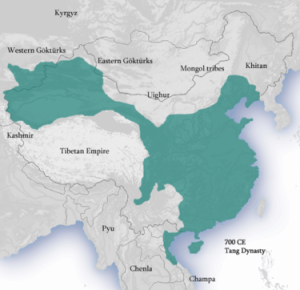 Tang Dynasty ca. 700 ce (Map courtesy of Wikipedia)
Tang Dynasty ca. 700 ce (Map courtesy of Wikipedia)
| Ruler Name | Chinese Characters | Dates of Rule | Length of Reign |
| 1. Gāo Zǔ | 高祖 | r. 618 to 626 ce | ruled 8 years |
| 20 additional emperors (and 1 Zhōu Dynasty empress) from 627 to 907 ce | Click to Display | ||
The Five Dynasties and Ten Kingdoms Period (wǔ dài 五代) 907 to 960 ce
An era of instability and political upheaval in China. The Five States developed and collapsed in quick succession in the central plain of China. This was the last period of multiple political divisions in Chinese dynastic history.
| Kingdom Name | Pinyin | Chinese Characters | Dates | Dynasty Duration |
| 1. Later Liáng Dynasty | hòu liáng cháo | 後梁朝/后梁朝 | 907 to 923 ce | 16 years |
| Founded by Zhū Wēn [朱溫/朱温] alias Zhū Quánzhōng [朱全忠] ruled as: Emperor Tài Zǔ (Founding Emperor) | ||||
| 2. Later Táng Dynasty | hòu táng cháo | 後唐朝/后唐朝 | 923 to 936 ce | 13 years |
| 3. Later Jìn Dynasty | hòu jìn cháo | 後晉朝/后晋朝 | 936 to 947 ce | 11 years |
| 4. Later Hàn Dynasty | hòu hàn cháo | 後漢朝/后汉朝 | 947 to 950 ce | 3 years |
| 5. Later Zhōu Dynasty | hòu zhōu cháo | 後周朝/后周朝 | 951 to 960 ce | 9 years |
Liáo Dynasty (liáo cháo 遼朝/辽朝) aka Khitan Empire (qì dān guó 契丹國/契丹国) 907 to 1125 ce – This ‘dynasty’ was contemporaneous with the Five Dynasties and Ten Kingdoms period and included the areas north of the Chinese central plains and extending into central Asia. – 9 emperors
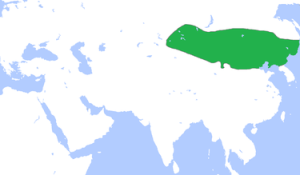 Liao Dynasty/Khitan Empire ca. 1000 ce (Map courtesy of Wikipedia)
Liao Dynasty/Khitan Empire ca. 1000 ce (Map courtesy of Wikipedia)
| Ruler Name | Chinese Characters | Dates of Rule | Length of Reign |
| 1. Liáo Tàizǔ | 遼太祖/辽太祖 | r. 907 to 926 ce | ruled 19 years |
| 8 additional emperors from 926 to 1125 ce | Click to Display | ||
Northern Sòng Dynasty (běi sòng cháo 北宋朝) 960 to 1126 ce – This dynasty is considered the first half of the Song Dynasty and had its capital at Kaifeng (開封/开封). It ended when its capital fell to the Jin, and continued in the south. – 9 emperors
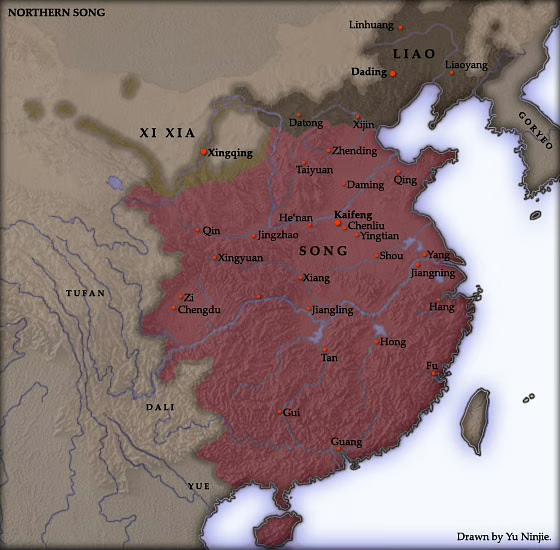 Northern Song Dynasty 960-1125ce (Map courtesy of Wikipedia)
Northern Song Dynasty 960-1125ce (Map courtesy of Wikipedia)
| Ruler Name | Chinese Characters | Birth name | Dates of Rule | Length of Reign |
| 1. Tàizǔ | 太祖 | Zhào Kuāngyìn 趙匡胤/赵匡胤 | r. 960 to 976 ce | ruled 16 years |
| 8 additional emperors from 976 to 1127 ce | Click to Display | |||
Western Xià Dynasty (aka Tangut Empire) (xī xià cháo 西夏朝) 990 to 1227 ce – Almost all traces of this dynasty and the Tangut peoples were effectively ‘erased’ by Genghis Khan and the Mongols in 1227 ce – 10 emperors
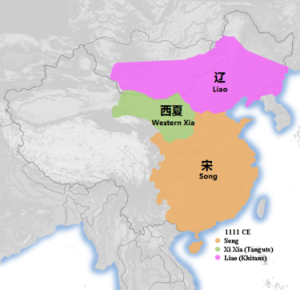 Song, Liao and Western Xia Dynasties ca. 1111 ce (Map courtesy of Wikipedia)
Song, Liao and Western Xia Dynasties ca. 1111 ce (Map courtesy of Wikipedia)
| Ruler Name | Chinese Characters | Posthumous name | Birth name | Dates of Rule | Length of Reign |
| 1. Jǐngzōng | 景宗 | Wǔliè Dì 武烈帝 | Lǐ Yuánhào 李元昊 | r. 1038 to 1048 ce | ruled 10 years |
| 9 additional emperors from 1048 to 1227 ce | Click to Display | ||||
Southern Sòng Dynasty (nán sòng cháo 南宋朝) 1127 to 1279 ce – Headquartered at Hangzhou (杭州) this dynasty continued the Song south of the Huai River (淮河). It built a strong navy and engaged heavily in foreign trade with Korea, Japan, SE Asia and India. It was ultimately conquered by the Mongol Yuan Dynasty under Kublai Khan in 1271 ce. – 9 emperors
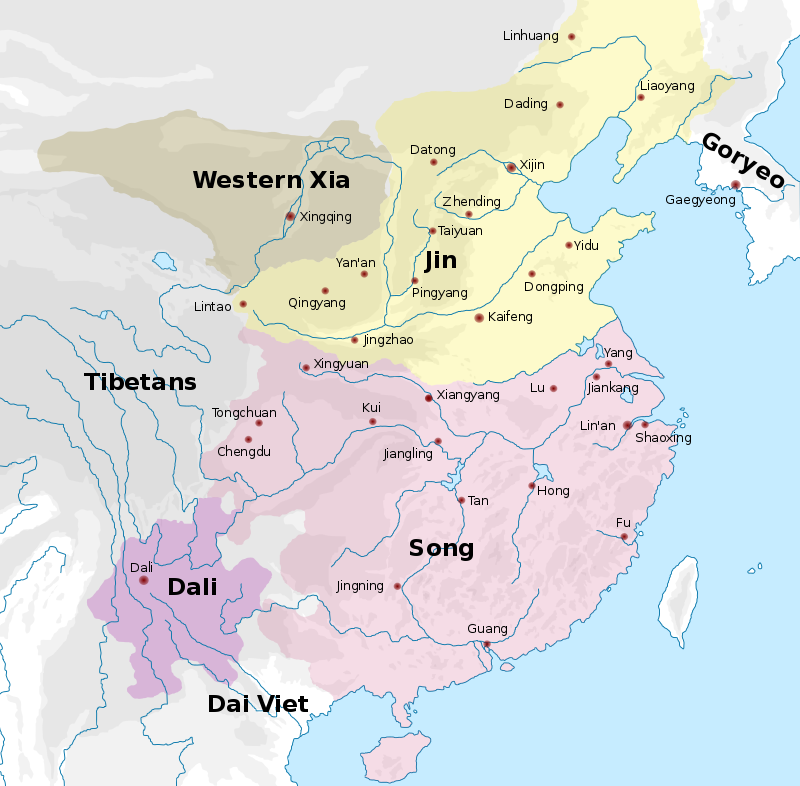 Southern Sòng Dynasty (Map courtesy of Wikipedia)
Southern Sòng Dynasty (Map courtesy of Wikipedia)
| Ruler Name | Chinese Characters | Birth name | Dates of Rule | Length of Reign |
| 1. Gāozōng | 高宗 | Zhào Gòu 趙構/赵构 | r. 1127 to 1162 ce | ruled 35 years |
| 8 additional emperors from 1162 to 1279 ce | Click to Display | |||
Jīn Dynasty (jīn cháo 金朝) 1115 to 1234 ce – a Jurchen dynasty in northern China – 10 emperors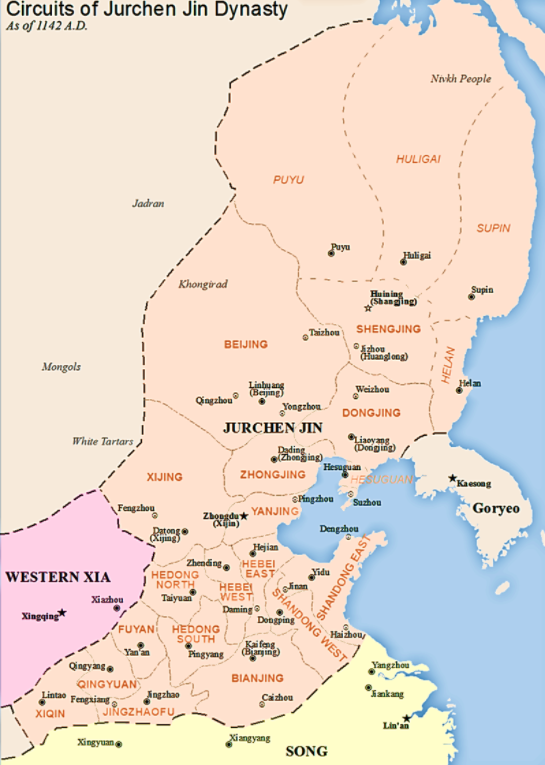 Jurchen Jin Dynasty ca 1141 ce (Map courtesy of Wikipedia)
Jurchen Jin Dynasty ca 1141 ce (Map courtesy of Wikipedia)
| Ruler Name | Chinese Characters | Dates of Rule | Length of Reign |
| 1. Tàizǔ (Founding emperor) | 太祖 | r. 1115 to 1123 ce | ruled 8 years |
| 9 additional emperors from 1123 to 1234 ce | Click to Display | ||
Yuán Dynasty (Mongol) (yuán cháo 元朝) 1271 to 1368 ce – 15 emperors
(*Kublai Khan promoted 5 of his ‘predecessors’ posthumously as emperor after he founded the dynasty in China in 1271 ce)
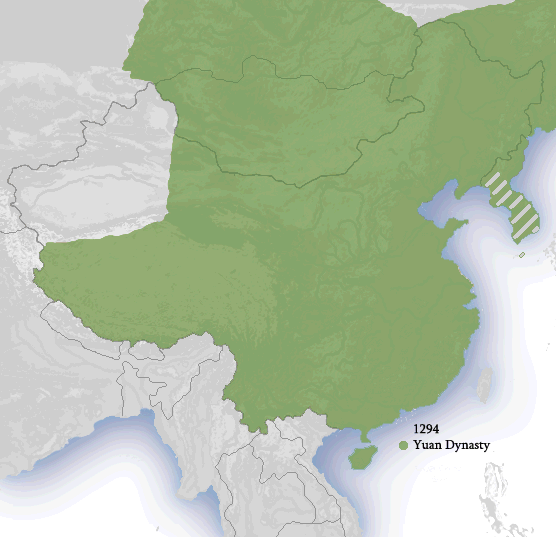 Yuán Dynasty ca 1294 ce (Map courtesy of Wikipedia)
Yuán Dynasty ca 1294 ce (Map courtesy of Wikipedia)
| Ruler Name | Chinese Characters | Dates of Rule | Length of Reign |
| 1. *Kublai Khan (Shìzǔ) (actual founder) | 世祖 | r. 1260 to 1294 ce (as Khan) | ruled 34 years as Khan, ruled China for 23 years as Emperor (1271 to 1294 ce) |
| 14 additional emperors from 1206 to 1370 ce (5 posthumously made emperor, 9 subsequent emperors after 1294 ce) |
Click to Display | ||
Míng Dynasty (míng cháo 明朝) 1368 to 1644 ce – 16 emperors – The last Chinese dynasty.
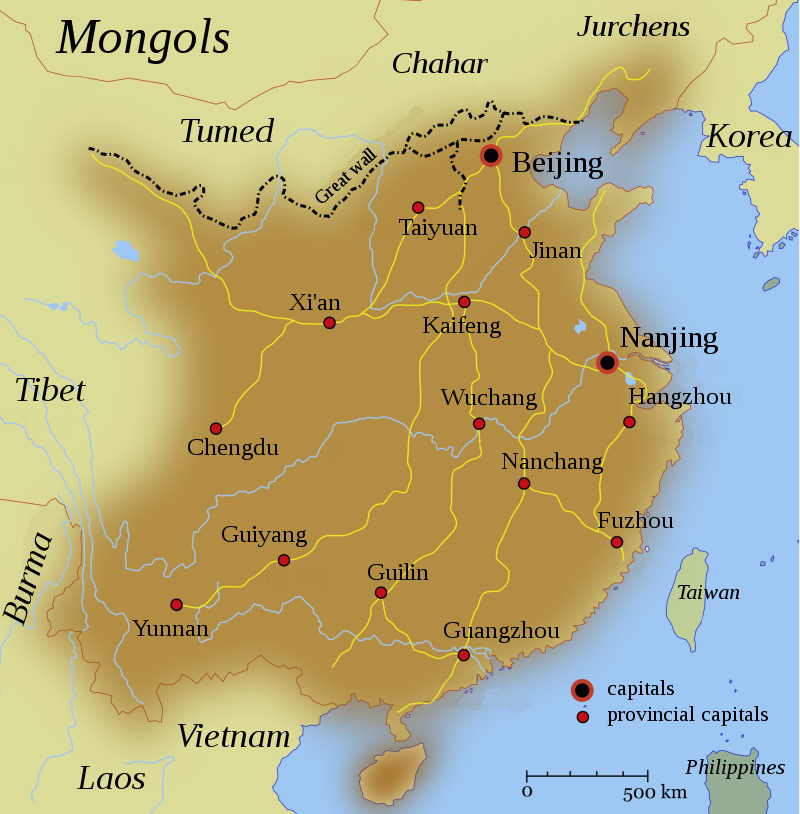 Ming Empire ca 1580 ce (Map courtesy of Wikipedia)
Ming Empire ca 1580 ce (Map courtesy of Wikipedia)
| Ruler Name | Chinese Characters | Dates of Rule | Length of Reign |
| 1. Hóngwǔ Emperor (Founding emperor: Tàizǔ 太祖) |
洪武 | r. 1368 to 1398 ce | ruled 30 years |
| 15 additional emperors from 1398 to 1644 ce | Click to Display | ||
Southern Míng Dynasty (nán míng cháo 南明朝) 1644 to 1662 ce – 7 emperors, the last executed in 1662 when the Qīng took Nánjīng
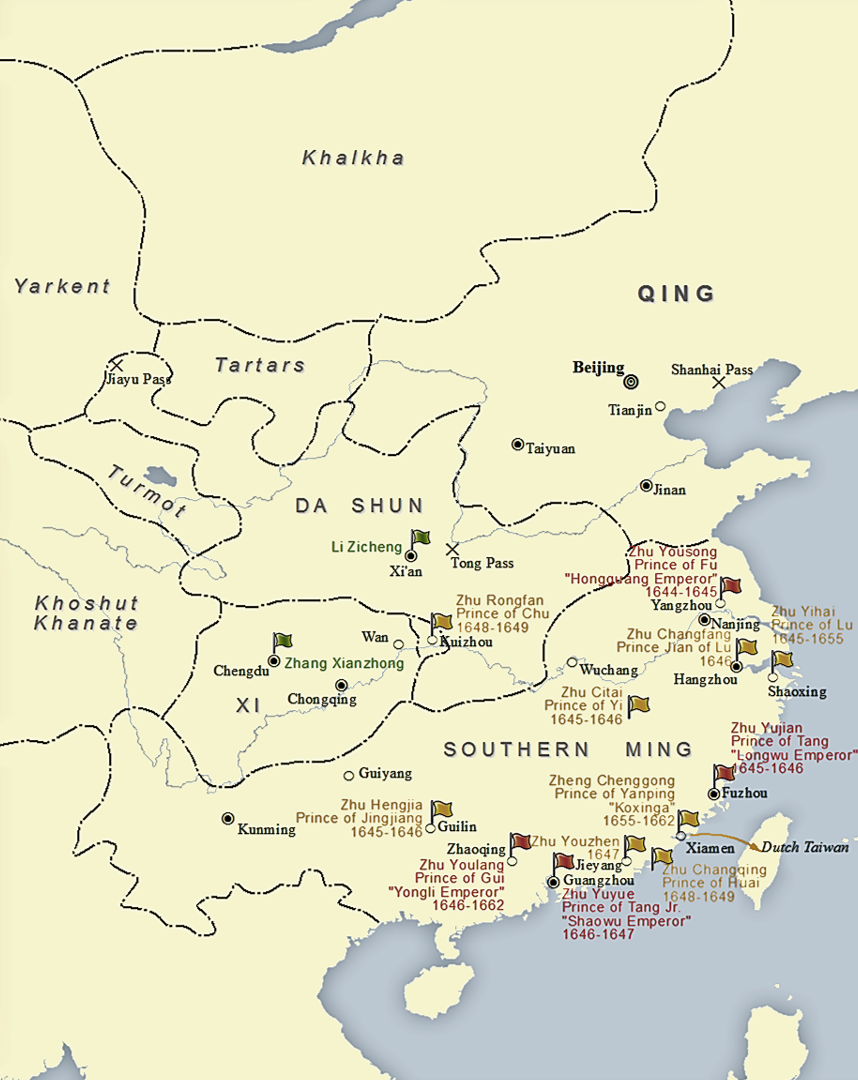 Southern Ming ca 1644 (Map courtesy of Wikipedia)
Southern Ming ca 1644 (Map courtesy of Wikipedia)
| Ruler Name | Chinese Characters | Dates of Rule | Length of Reign |
| 1. Prince of Fu (Fú Wáng) | 福王 | 1644–1645 | 1 year |
| 6 additional emperors from 1645 to 1662 ce | Click to Display | ||
Qīng Dynasty (Manchu) (qīng cháo 清朝) 1644 to 1912 ce – This was a Manchu dynasty, which overthrew the last Chinese dynasty (the Míng). – 12 emperors and one regent
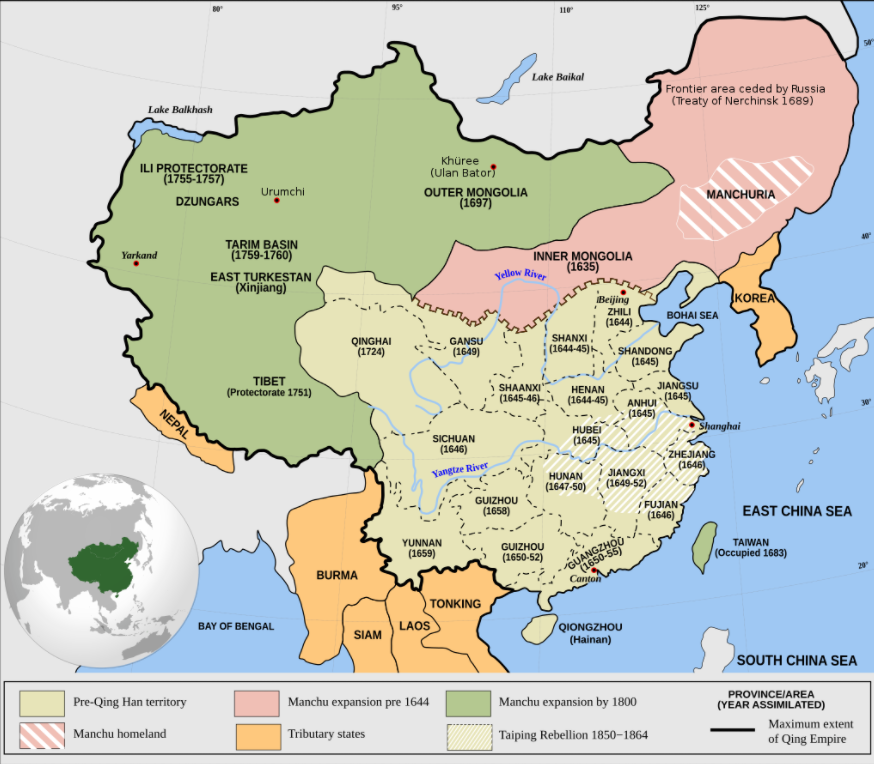 Qing Empire ca 1820 (Map courtesy of Wikipedia)
Qing Empire ca 1820 (Map courtesy of Wikipedia)
| Ruler Name | Chinese Characters | Dates of Rule | Length of Reign |
| 1. The Founding Emperor (Taizu 太祖) was Nurhachi (era name: Tiānmìng) | 天命 | r. 1616 to 1626 ce | ruled 10 years |
| 11 additional emperors from 1626 to 1912 ce | Click to Display | ||
End of 2,133 years of Chinese dynastic history…
Modern Period
Chinese Revolution of 1911 (The Xīnhài Revolution) (xīn hài gé mìng 辛亥革命)
Republic of China 1912 to 1949 ce (China), 1949 ce to present (Taiwan) (zhōng huá mín guó 中華民國/中华民国)
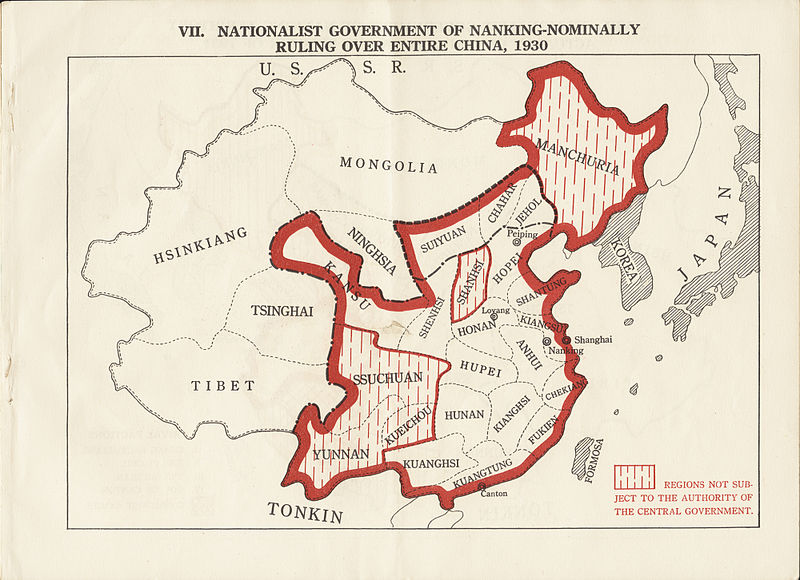 Republic of China 1930 (Map courtesy of Wikipedia)
Republic of China 1930 (Map courtesy of Wikipedia)
People’s Republic of China 1949 ce to present (China) (zhōng huá rén mín gòng hé guó 中華人民共和國/中华人民共和国)
© R. Teller, 2015

